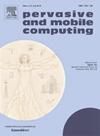Machinery detection by impulsive noise recognition using WiFi sensing
IF 3.5
3区 计算机科学
Q2 COMPUTER SCIENCE, INFORMATION SYSTEMS
引用次数: 0
Abstract
Engines and electrical devices in operation generate electromagnetic pulses, also called impulsive noise (IN), that interfere with wireless signals. The IN shall affect the channel estimation process and is, therefore, present in the channel state information (CSI) provided by wireless receivers. In this paper, impulsive noise (IN) is used as a fingerprint of electrical devices to identify the IN sources that interfere with a WiFi signal, taking into account that each individual machine has a unique pattern of impulsive noise. In this sense, the WiFi CSI provides valuable information to recognize the IN sources through deep learning (DL) strategies. Two DL models have been proposed and tested on two experimental data sets for multiclass and multilabel analysis; in multiclass, devices can operate alone during the measurement, and in multilabel, multiple devices can work simultaneously in a more realistic scenario. The model transferability between location and days has also been evaluated by analyzing two different IN feature sets for device classification with the Few-shot-learning (FSL) model. Results show that the proposed DL models can recognize multiple devices working simultaneously through the IN and also offer an acceptable transferability performance ( 80% accuracy for a five-class problem).
基于WiFi传感的脉冲噪声识别机械检测
发动机和运行中的电气设备产生电磁脉冲,也称为脉冲噪声(in),干扰无线信号。IN将影响信道估计过程,因此,它存在于无线接收器提供的信道状态信息(CSI)中。在本文中,考虑到每台机器都有独特的脉冲噪声模式,脉冲噪声(In)被用作电子设备的指纹来识别干扰WiFi信号的In源。从这个意义上说,WiFi CSI通过深度学习(DL)策略为识别In源提供了有价值的信息。提出了两个深度学习模型,并在两个实验数据集上进行了多类和多标签分析的测试;在多类别中,设备可以在测量过程中单独运行,而在多标签中,多个设备可以在更现实的场景中同时工作。通过使用Few-shot-learning (FSL)模型分析两种不同的设备分类IN特征集,还评估了模型在位置和日期之间的可转移性。结果表明,所提出的深度学习模型可以识别通过IN同时工作的多个设备,并且还提供了可接受的可转移性性能(对于五类问题的准确率为80%)。
本文章由计算机程序翻译,如有差异,请以英文原文为准。
求助全文
约1分钟内获得全文
求助全文
来源期刊

Pervasive and Mobile Computing
COMPUTER SCIENCE, INFORMATION SYSTEMS-TELECOMMUNICATIONS
CiteScore
7.70
自引率
2.30%
发文量
80
审稿时长
68 days
期刊介绍:
As envisioned by Mark Weiser as early as 1991, pervasive computing systems and services have truly become integral parts of our daily lives. Tremendous developments in a multitude of technologies ranging from personalized and embedded smart devices (e.g., smartphones, sensors, wearables, IoTs, etc.) to ubiquitous connectivity, via a variety of wireless mobile communications and cognitive networking infrastructures, to advanced computing techniques (including edge, fog and cloud) and user-friendly middleware services and platforms have significantly contributed to the unprecedented advances in pervasive and mobile computing. Cutting-edge applications and paradigms have evolved, such as cyber-physical systems and smart environments (e.g., smart city, smart energy, smart transportation, smart healthcare, etc.) that also involve human in the loop through social interactions and participatory and/or mobile crowd sensing, for example. The goal of pervasive computing systems is to improve human experience and quality of life, without explicit awareness of the underlying communications and computing technologies.
The Pervasive and Mobile Computing Journal (PMC) is a high-impact, peer-reviewed technical journal that publishes high-quality scientific articles spanning theory and practice, and covering all aspects of pervasive and mobile computing and systems.
 求助内容:
求助内容: 应助结果提醒方式:
应助结果提醒方式:


